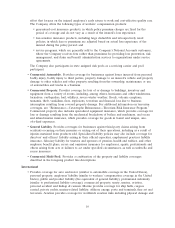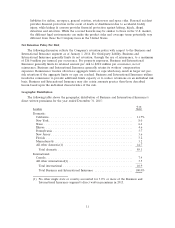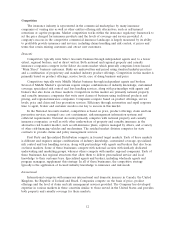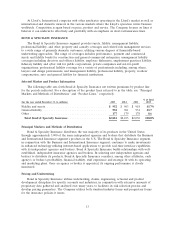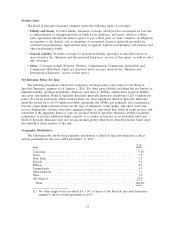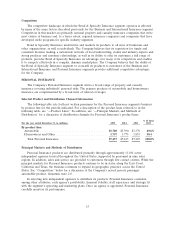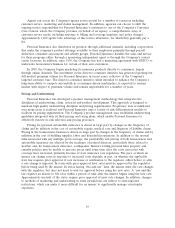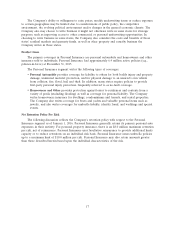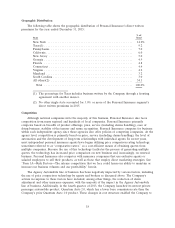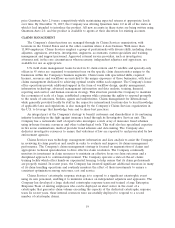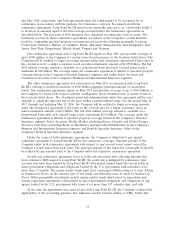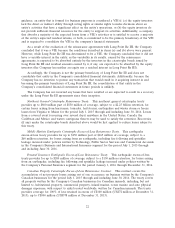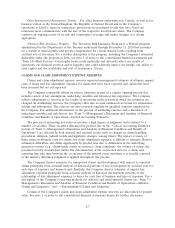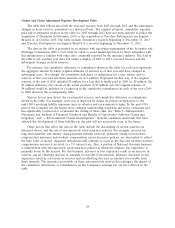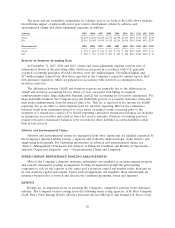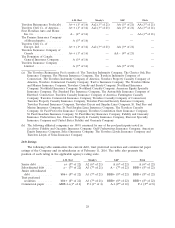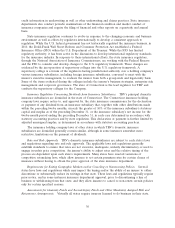Travelers 2015 Annual Report Download - page 20
Download and view the complete annual report
Please find page 20 of the 2015 Travelers annual report below. You can navigate through the pages in the report by either clicking on the pages listed below, or by using the keyword search tool below to find specific information within the annual report.REINSURANCE
The Company reinsures a portion of the risks it underwrites in order to manage its exposure to
losses and to protect its capital. The Company cedes to reinsurers a portion of these risks and pays
premiums based upon the risk and exposure of the policies subject to such reinsurance. The Company
utilizes a variety of reinsurance agreements to manage its exposure to large property and casualty
losses, including catastrophe, treaty, facultative and quota share reinsurance. Ceded reinsurance
involves credit risk, except with regard to mandatory pools and associations, and is predominantly
subject to aggregate loss limits. Although the reinsurer is liable to the Company to the extent of the
reinsurance ceded, the Company remains liable as the direct insurer on all risks reinsured. Reinsurance
recoverables are reported after reductions for known insolvencies and after allowances for uncollectible
amounts. The Company also holds collateral, including trust agreements, escrow funds and letters of
credit, under certain reinsurance agreements. The Company monitors the financial condition of
reinsurers on an ongoing basis and reviews its reinsurance arrangements periodically. Reinsurers are
selected based on their financial condition, business practices, the price of their product offerings and
the value of collateral provided. After reinsurance is purchased, the Company has limited ability to
manage the credit risk to a reinsurer. In addition, in a number of jurisdictions, particularly the
European Union and the United Kingdom, a reinsurer is permitted to transfer a reinsurance
arrangement to another reinsurer, which may be less creditworthy, without a counterparty’s consent,
provided that the transfer has been approved by the applicable regulatory and/or court authority.
For additional information regarding reinsurance, see note 5 of notes to the consolidated financial
statements and ‘‘Item 1A—Risk Factors’’ herein. For a description of reinsurance-related litigation, see
note 16 of notes to the consolidated financial statements herein.
Catastrophe Reinsurance
Catastrophes can be caused by a variety of events, including, among others, hurricanes, tornadoes
and other windstorms, earthquakes, hail, wildfires, severe winter weather, floods, tsunamis, volcanic
eruptions and other naturally-occurring events, such as solar flares. Catastrophes can also result from
terrorist attacks and other intentionally destructive acts including those involving nuclear, biological,
chemical, radiological, cyber-attacks, explosions and infrastructure failures. The incidence and severity
of catastrophes are inherently unpredictable. The extent of losses from a catastrophe is a function of
both the total amount of insured exposure in the area affected by the event and the severity of the
event. Most catastrophes are restricted to small geographic areas; however, hurricanes and earthquakes
may produce significant damage in larger areas, especially those areas that are heavily populated. The
Company generally seeks to manage its exposure to catastrophes through individual risk selection and
the purchase of catastrophe reinsurance. The following discussion summarizes the Company’s
catastrophe reinsurance coverage at December 31, 2015.
Corporate Catastrophe Excess-of-Loss Reinsurance Treaty. This treaty covers the accumulation of
certain property losses arising from one or multiple occurrences for the period January 1, 2016 through
and including December 31, 2016: 75% ($1.5 billion) of qualifying losses covered by the treaty and 25%
($500 million) of qualifying losses retained by the Company part of $2.0 billion excess of $3.0 billion.
Qualifying losses for each occurrence are after a $100 million deductible. The treaty covers all of the
Company’s exposures in the United States and Canada and their territories and possessions, the
Caribbean Islands, Mexico and all waters contiguous thereto. The treaty only provides coverage for
terrorism events in limited circumstances and excludes entirely losses arising from nuclear, biological,
chemical or radiological attacks.
Catastrophe Bonds. The Company has catastrophe protection through two indemnity reinsurance
agreements with Long Point Re III Ltd. (Long Point Re III), an independent Cayman Islands company
licensed as a Class C insurer in the Cayman Islands. The reinsurance agreements expire in May 2016
20


